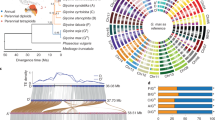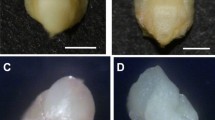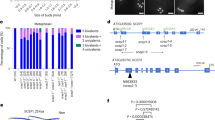Abstract
Avena maroccana (2n = 4x = 28) and A. sativa (2n = 6x = 42) are allopolyploids. Reconstructions from electron micrographs of synaptonemal complexes in serial sections of pollen mother cells showed that associations at zygotene and subsequent stages of meiosis are confined to homologous chromosomes only, with the result that only bivalents are generated. Such “classical” behaviour contrasts sharply with that in allopolyploids of wheat, Lolium and Scilla. In these pairing at zygotene involves homoeologous as well as homologous chromosomes, generating not only bivalents but multivalents which are “resolved” to bivalents prior to first metaphase.
An analysis is presented, also, of structural and genetic factors which influence the distribution of pairing within and between chromosomes at zygotene in the Avena species.
Similar content being viewed by others
Article PDF
References
Evans, G M, Macefield, A J (1973). The effect of B chromosomes on homoeologous pairing in species hybrids. 1. Lolium temulentum × Lolium perenne. Chromosoma, 41, 63–73.
Gauthier, F M, McGinnis, R C (1968). The Meiotic behaviour of a nulli-haploid plant in Avena Sativa L. Can J Genet Cytol, 10, 186–189.
Hobolth, P (1981). Chromosome pairing in allohexaploid wheat var. Chinese Spring. Transformation of multivalents into bivalents, a mechanism for exclusively bivalent formation. Carlsberg Res Commun, 46, 129–173.
Holm, P B (1986). Chromosome pairing and chiasma formation in allohexaploid wheat, Triticum aestivum analysed by spreading of meiotic nuclei. Carlsberg Res Commun, 51, 239–294.
Holm, P B (1988). Chromosome pairing and synaptonemal complex formation in hexaploid wheat, Monoisosomic and diisosomic for the long arm of chromosome 5B. Carlsberg Res Commun, 53, 111–133.
Holm, P B, Wang, X (1988). The effect of chromosome 5B on synapsis and chiasma formation in wheat, Triticum aestivum cv. Chinese Spring. Carlsberg Res Commun, 53, 191–208.
Jenkins, G (1983). Chromosome pairinginTriticum aestivum cv. Chinese Spring. Carlsberg Res Commun, 48, 255–283.
Jenkins, G (1985a). Synaptonemal complex formation in hybrids of Lolium temulentum × Lolium perenneI. Diploid. Chromosoma, 92, 81–88.
Jenkins, G (1985b). Synaptonemal complex formation in hybrids of Lolium temulentum × Lolium perenne II. Triploid. Chromosoma, 92, 387–390.
Jenkins, G (1986). Synaptonemal complex formation in hybrids of Lolium temulentum × Lolium perenne III. Tetraploid. Chromosoma, 93, 413–419.
Jenkins, G, White, J, Parker, J S (1988). Elimination of multivalents during meiotic prophasein Scilla autumnalis II. Tetraploid. Genome, 30, 940–946.
Kimber, G, Riley, R (1963). The relationships of the diploid progenitors of hexaploid wheat. Can J Genet Cytol, 5, 83–88.
Leggett, J M (1977). The meiotic be haviour of aneupolyhaploids of the cultivated oat Avena sativa(2n=6x=42). Can J Genet Cytol, 19, 651–656.
Loidl, J (1988). SC formation in some allium species and a discussion of the significance of SC-associated structures and of the mechanisms for pre-Synaptic alignment. Pl Syst Evol, 158, 117–131.
Mather, K (1943). Statistical analysis in Biology. Methuen (London).
Nishiyama, I, Yabuno, T (1975). Meiotic chromosome pairing in two interspecific hybrids and a criticism of the evolutionary relationship of diploid. Avena Jap J Genet, 50, 443–451.
Rajhathy, T (1963). A standard karyotype of Avena sativa. Can J Genet Cytol, 5, 127–132.
Rajhathy, T (1971). The allopolyploid model in Avena. Stadler Symposia, 3, 71–87.
Rajhathy, T, Dyck, P L (1963). Chromosomal differentiation and speciation in diploid Avena II. Karyotype of Avena pilosa. Can J Genet Cytol, 5, 175–179.
Rajhathy, T, Thomas, H (1967). Chromosomal differentiation and speciation in diploid AvenaIII. Mediterranean wild populations. Can J Genet Cytol, 3, 372–377.
Rajhathy, T, Thomas, H (1972). Genetic control of chromosome pairing in hexaploid oats. Nature New Biology, 239, 217–219.
Rajhathy, T, Thomas, H (1974). Cytogenetics of oats (Avena L.). Misc Pub Genet Soc Canada, 2, 1–91.
Riley, R, Chapman, V (1958). Genetic control of the cytologically diploid behaviour of hexaploid wheat. Nature, 182, 713–715.
Sears, E R (1941). Chromosome pairing and fertility in hybrids and amphidiploids in theTriticinae. Res Bull Missouri Agric Expt Sta, 337.
Sears, E R, Okamoto, M (1958). Intergenomic chromosome relationships in hexaploid wheat (Abstr.). Proc X Int Cong Genet, 2, 258–259.
Thomas, H. Cytogenetics of Avena. Oat Monograph, 2nd ed, (In press).
Wells, B (1974). A convenient technique for the collection of ultrathin sections. Micron, 5, 79–81.
Author information
Authors and Affiliations
Rights and permissions
About this article
Cite this article
Jones, M., Rees, H. & Jenkins, G. Synaptonemal complex formation in Avena polyploids. Heredity 63, 209–219 (1989). https://doi.org/10.1038/hdy.1989.94
Received:
Issue date:
DOI: https://doi.org/10.1038/hdy.1989.94



